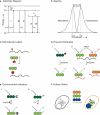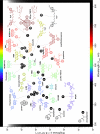Bright ideas for chemical biology
- PMID: 18355003
- PMCID: PMC2802578
- DOI: 10.1021/cb700248m
Bright ideas for chemical biology
Abstract
Small-molecule fluorescent probes embody an essential facet of chemical biology. Although numerous compounds are known, the ensemble of fluorescent probes is based on a modest collection of modular "core" dyes. The elaboration of these dyes with diverse chemical moieties is enabling the precise interrogation of biochemical and biological systems. The importance of fluorescence-based technologies in chemical biology elicits a necessity to understand the major classes of small-molecule fluorophores. Here, we examine the chemical and photophysical properties of oft-used fluorophores and highlight classic and contemporary examples in which utility has been built upon these scaffolds.
Figures


References
-
- Petit J-M, Denis-Gay M, Ratinaud M-H. Assessment of fluorochromes for cellular structure and function studies by flow cytometry. Biol. Cell. 1993;78:1–13. - PubMed
-
- Waggoner A, Kenneth S. Covalent labeling of proteins and nucleic acids with fluorophores. Methods Enzymol. 1995;246:362–373. - PubMed
-
- Johnson I. Fluorescent probes for living cells. Histochem. J. 1998;30:123–140. - PubMed
-
- Boonacker E, Van Noorden CJF. Enzyme cytochemical techniques for metabolic mapping in living cells, with special reference to proteolysis. J. Histochem. Cytochem. 2001;49:1473–1486. - PubMed
-
- Zhang J, Campbell RE, Ting AY, Tsien RY. Creating new fluorescent probes for cell biology. Nat. Rev. Mol. Cell Biol. 2002;3:906–918. - PubMed
Publication types
MeSH terms
Substances
Grants and funding
LinkOut - more resources
Full Text Sources
Other Literature Sources
Molecular Biology Databases

